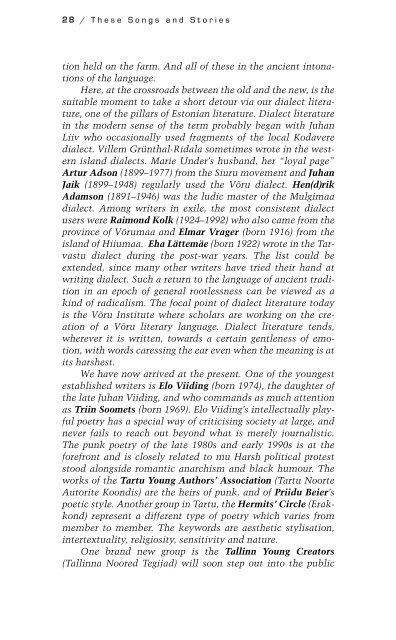*tuule makett - Infopoint Estonian Culture
*tuule makett - Infopoint Estonian Culture
*tuule makett - Infopoint Estonian Culture
Create successful ePaper yourself
Turn your PDF publications into a flip-book with our unique Google optimized e-Paper software.
2 8 / These Songs and Stories<br />
tion held on the farm. And all of these in the ancient intonations<br />
of the language.<br />
Here, at the crossroads between the old and the new, is the<br />
suitable moment to take a short detour via our dialect literature,<br />
one of the pillars of <strong>Estonian</strong> literature. Dialect literature<br />
in the modern sense of the term probably began with Juhan<br />
Liiv who occasionally used fragments of the local Kodavere<br />
dialect. Villem Grünthal-Ridala sometimes wrote in the western<br />
island dialects. Marie Under’s husband, her “loyal page”<br />
Artur Adson (1899–1977) from the Siuru movement and Juhan<br />
Jaik (1899–1948) regularly used the Võru dialect. Hen(d)rik<br />
Adamson (1891–1946) was the ludic master of the Mulgimaa<br />
dialect. Among writers in exile, the most consistent dialect<br />
users were Raimond Kolk (1924–1992) who also came from the<br />
province of Võrumaa and Elmar Vrager (born 1916) from the<br />
island of Hiiumaa. Eha Lättemäe (born 1922) wrote in the Tarvastu<br />
dialect during the post-war years. The list could be<br />
extended, since many other writers have tried their hand at<br />
writing dialect. Such a return to the language of ancient tradition<br />
in an epoch of general rootlessness can be viewed as a<br />
kind of radicalism. The focal point of dialect literature today<br />
is the Võru Institute where scholars are working on the creation<br />
of a Võru literary language. Dialect literature tends,<br />
wherever it is written, towards a certain gentleness of emotion,<br />
with words caressing the ear even when the meaning is at<br />
its harshest.<br />
We have now arrived at the present. One of the youngest<br />
established writers is Elo Viiding (born 1974), the daughter of<br />
the late Juhan Viiding, and who commands as much attention<br />
as Triin Soomets (born 1969). Elo Viiding’s intellectually playful<br />
poetry has a special way of criticising society at large, and<br />
never fails to reach out beyond what is merely journalistic.<br />
The punk poetry of the late 1980s and early 1990s is at the<br />
forefront and is closely related to mu Harsh political protest<br />
stood alongside romantic anarchism and black humour. The<br />
works of the Tartu Young Authors’ Association (Tartu Noorte<br />
Autorite Koondis) are the heirs of punk, and of Priidu Beier’s<br />
poetic style. Another group in Tartu, the Hermits’ Circle (Erakkond)<br />
represent a different type of poetry which varies from<br />
member to member. The keywords are aesthetic stylisation,<br />
intertextuality, religiosity, sensitivity and nature.<br />
One brand new group is the Tallinn Young Creators<br />
(Tallinna Noored Tegijad) will soon step out into the public


